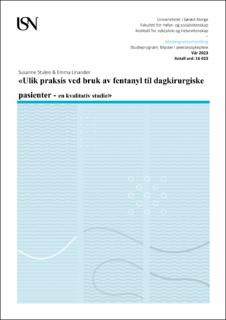| dc.contributor.advisor | Flo, Jill Britt-Marie | |
| dc.contributor.author | Stulen, Susanne | |
| dc.contributor.author | Linander, Emma | |
| dc.date.accessioned | 2023-07-18T16:41:55Z | |
| dc.date.available | 2023-07-18T16:41:55Z | |
| dc.date.issued | 2023 | |
| dc.identifier | no.usn:wiseflow:6846425:54802398 | |
| dc.identifier.uri | https://hdl.handle.net/11250/3079971 | |
| dc.description.abstract | Bakgrunn: Det er foreløpig ingen standard på hvordan anestesisykepleiere administrerer fentanyl perioperativt til dagkirurgiske pasienter. Det er gjort flere kvantitative studier angående opioidbruk hos dagkirurgiske pasienter, dog ser vi lite forskning på den kvalitative siden med anestesisykepleierens erfaringer på temaet. Det er blitt sett i vår praksis at anestesisykepleiere administrerer fentanyl ulikt. Vi ønsket også å finne ut av om effektivitet var en påvirkningsfaktor med tanke på å administrere fentanyl. Problemstillingen ble «Hvordan vurderer anestesisykepleieren sin administrering av fentanyl til dagkirurgiske pasienter perioperativt?»
Hensikten: Denne studien har som hensikt å gi ny innsikt i anestesisykepleierens erfaring med administrering av opioidet fentanyl, hva slags faktorer som ligger til grunn for deres vurderinger, samt å kunne bidra til videre kvalitetsarbeid.
Metode: For å hensiktsmessig svare på vår problemstilling har vi valgt et kvalitativt design med enkeltintervjuer som metode. Vi anvendte Kirsti Malterud til systematiske tekstkondensering som analysemetode. I denne studien er det gjort ni intervjuer med anestesisykepleiere som jobbet ved ett sykehus.
Resultater: Anestesisykepleierne i denne studien erfarer at de bruker mindre fentanyl på dagkirurgisk avdeling enn på den generelle operasjonsavdelingen, men at det ikke skal gå på bekostning av pasientens velvære. Det ble påpekt at tidspress var en faktor som påvirket anestesisykepleierne i administreringen av fentanyl. Ifølge informantene var det ingen gitt standard på hvordan fentanyl skal administreres perioperativt. Lokalbedøvelse og blokader spilte en stor rolle for anestesisykepleierne i forhold til dosering av fentanyl. Anestesisykepleierne innhenter informasjon om hvor mye fentanyl de bør gi ut ifra blant annet kliniske vitale parametere hos pasienten, andre kollegaer samt søk digitalt.
Konklusjon: Anestesisykepleierne vurderer administreringen av fentanyl ulikt. Blant annet vurderer de ut ifra pasientens alder, vitale parametere, bruk av lokalbedøvelse og andre medikamenter. Anestesisykepleierne ga uttrykk for at det var stort fokus på effektivisering på dagkirurgisk avdeling. Dette medførte at de gav mindre fentanyl til pasientene perioperativt. | |
| dc.description.abstract | Background: There is currently no specific standard for how to administrate fentanyl perioperatively to ambulatory surgical patients. There have been several quantitative research studies done on the use of opioids on day-surgery patients. However, there is minimal research on the qualitative aspect of nurse anesthetists´ experiences on the subject. It has come to our attention during anesthesia practice, that nurse anesthetists administrate fentanyl differently to one another. We also wanted to find out if efficiency was an influencing factor with regards to the administration of fentanyl. The thesis was therefore: “How does the nurse anesthetist determine the administration of fentanyl to ambulatory surgical patients perioperatively?”
Aim: This study aims to give a new insight into nurse anesthetists´ experiences with the administration of the opioid fentanyl and what kind of factors that influence their assessments, as well as being able to contribute to further qualitative work.
Method: To appropriately answer our thesis question, we decided on a qualitative design with individual interviews as the method. We chose systematic text condensation by Kirsti Malterud as the analysis method. In this study nine interviews were carried out, with nurse anesthetists that worked at a hospital.
Results: The nurse anesthetists in this study experienced that they give less fentanyl in the ambulatory surgical unit than in the main operating department, though it shouldn´t be at the expense of the patient´s well-being. It was pointed out that time pressure was a factor that affected the nurse anesthetist´s administration of fentanyl. According to the participants there was no standard for the administration of fentanyl perioperatively. Local anesthetics and peripheral nerve blocks played a role in what dosage of fentanyl the nurse anesthetists gave. The nurse anesthetists gather information on how much fentanyl they should use from the patients’ vital parameters, other colleagues and digital searches, among others.
Conclusion: The nurse anesthetists assessed their administration of fentanyl differently to one another. They considered, among others, the patients age, vital parameters, use of local anesthetics and other drugs. The nurse anesthetists gave the impression that there was a heightened focus on efficiency on the ambulatory surgical unit. This led to them giving less fentanyl to the patients perioperatively. | |
| dc.language | nob | |
| dc.publisher | University of South-Eastern Norway | |
| dc.title | Ulik praksis ved bruk av fentanyl til dagkirurgiske pasienter - en kvalitativ studie | |
| dc.type | Master thesis | |
